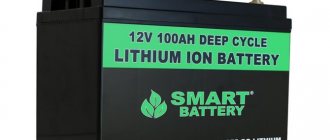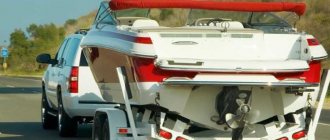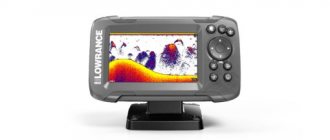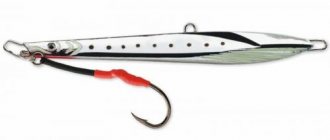Main types
There are several types of batteries for outboard motors:
- Starter;
- Traction;
- Universal.
The former are used to quickly start a diesel or gasoline engine. The main disadvantage is that they cannot be heavily loaded, and the charge does not last long.
Traction is another matter. They have a stable high DC current value. They can work for a long time. They are not afraid of oxidation due to the design features. They belong to deep-cycle batteries and have an increased number of cycles.
Universal batteries are able to provide high starting current and also work as a deep-discharge power source.
Features of batteries for boat motors
A peculiarity of the operation of batteries for outboard motors is the prolonged discharge of the battery. To ensure long-term operation of the electric motor, the battery must have a large capacity, and, given the frequent complete discharges of the battery, increased resistance to deep discharges.
At 6 volts
Thanks to specially decarbonized technology, it was possible to achieve battery resistance to multiple full discharges. In addition, longer operation of a charged device will significantly increase the range of swimming on a boat equipped with an electric motor.
Types of batteries, their pros and cons
The following types are used:
- WET – lead-acid
- AGM AND GEL
- Li-On – lithium-ion
Lead acid is the most commonly used. They are maintenance free. There is no need to add water to the jars using them. The main disadvantage of these batteries: if they are often completely discharged, then part of the capacity will be lost.
AGM AND GEL - often used with electric boat motors. They are not afraid of deep discharge and can produce a high starting current for the motor, even if discharged. They charge very quickly, do not emit gases and do not require maintenance. The disadvantages are that they cannot be recharged, as well as the high cost.
Lithium-ion batteries are rapidly gaining popularity. They are constantly being improved, despite the fact that they appeared only recently. They have overcharge protection.
Pros:
- Energy intensity;
- No maintenance required;
- Small percentage of wear and tear (10% per year);
- Charges quickly;
- Lightweight and compact.
One of the downsides is the price of batteries. Approximate cost – 20 thousand rubles.
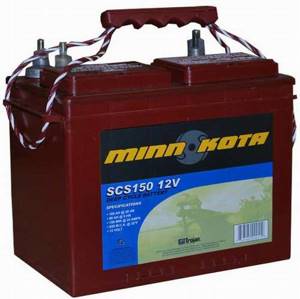
Lead-acid - the most commonly used, they are maintenance-free
Types of traction batteries for boat motors
There are a huge number of traction battery models on the market that can be used as an electric power unit to power both small watercraft made of PVC and massive metal boats. Such products may differ in size, capacity and maximum discharge current. The cost of traction power sources can also vary greatly. This value is significantly influenced by the technology by which the battery was manufactured. Modern products can cost several times more than older lead-acid batteries.
Gel batteries for boats
In gel traction batteries, the electrolyte is in a jelly-like state, so this battery is very convenient to use when the product needs to be moved frequently. In devices of this type, the electrolyte does not evaporate, so the product can be made maintenance-free.
Thanks to the original design of the separators, the possibility of plates shedding during operation is completely eliminated, which allows the device to be used in various operating modes for at least 5 years. The disadvantages of gel batteries, in addition to high cost, include insufficient stability of operation at low air temperatures and a decrease in service life due to frequent battery recharges.
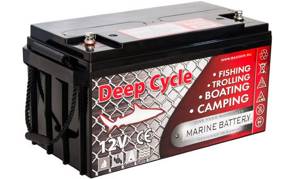
Gel
Lithium batteries for boat electric motors
Lithium traction batteries have high energy capacity, are lightweight and can withstand up to 3,000 battery charge and discharge cycles. Such products are very expensive, but after purchase you can use the device in the most intensive mode for several years. In addition to the high cost, the disadvantages of the product include an increased risk of fire when the device is depressurized, short circuited, or too much charging voltage and current is supplied to the contacts.
AGM batteries for boats
An AGM battery is a lead-acid product in which the plates are encased in a fiberglass "case". Such batteries are made maintenance-free, because there is no need to remove excess gas. The product has an increased service life due to the absence of plate shedding and relatively high resistance to deep discharges. The cost of AGM batteries is significantly higher than conventional lead-acid products, but given the increased service life of such a battery, the purchase will be more profitable.
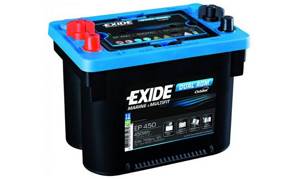
AGM
Lead-acid traction batteries for boats
Lead-acid batteries are the cheapest of traction devices, but the operation of such products is associated with many inconveniences. First of all, the limitation is imposed on the way the battery is installed. The product should only be used in a horizontal position.
Models being serviced may emit hazardous gases, and if the case is tilted, the electrolyte may be spilled, which can lead to oxidation of the metal surface with subsequent destruction. Also, such products have greater weight and size, which will be a very big disadvantage on a small craft.
Deep cycle batteries for outboard motors
The traction battery must be able to withstand multiple deep discharges. For installation on watercraft, products with a capacity of 70 to 100 A/h and a voltage of 12 volts are usually used.
Lithium batteries are most suitable for deep discharge. Such batteries are not always affordable, so a good alternative can be gel products, which, in addition to good tolerance to deep discharges, have a relatively small weight and are completely sealed.
Battery selection
When choosing a battery for your engine, look at what type of engine it is. They can be 12V or 24V. For 24V you will have to connect two 12V in series.
If you plan to use one battery, you need to choose AGM or GEL. If possible, buy a lithium-ion battery. It is expensive, but it will do its job better than others.
Regarding the capacity. It depends on the power of the motor. If the motor is powerful, then an appropriate capacity is required. An electric motor's consumption is approximately one amp per pound of motor power. If the motor has 25 lbs, then a 50 Ah battery will last it for 2 hours at maximum speed. At low speed it will last for the whole weekend, perhaps even more.
The power of electric boat motors cannot be measured in horsepower or kilowatts. For them there are such concepts as emphasis and traction.
Thrust is the force that the propeller develops when it rotates. This force is transferred to the ship and it moves in a horizontal direction. The emphasis is expressed in pounds, since electric motors are mainly produced by Americans.
Often, a 100-pound boat needs 2 pounds of thrust. But it is better to take with a margin of 10%.
Select the battery so that at full power the charge will last for two hours.
Look at the weight. It is better if it is within 20 kg so that it does not interfere with control.
Choose a maintenance-free battery. You only have to recharge it. And it’s good if it has minimal self-charging.
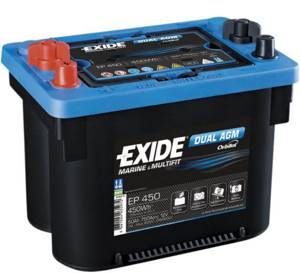
Electric motor consumption is approximately one amp per pound of motor power.
Models and cost
CROWN 12 V is a traction battery for outboard motors with compact dimensions. Does not deteriorate from deep discharges. It also has a maximum number of deep discharge-charge cycles.
Characteristics:
- Capacity: 85 A*h;
- Max I: 730 A;
- Weight: 20 kilograms;
- Price: about 6946 rub.
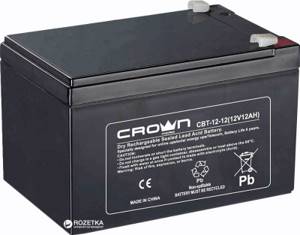
DEKADP 24 series MarineMaster (USA) – deep discharge battery. Able to withstand full discharge and long recharge without problems. Specially designed to work in harsh conditions.
Characteristics:
- Capacity: 85 A*h;
- Max I: 550 A;
- Weight: 17.7 kilograms;
- Price: about 5750 rub.

DEKA DC31 DT series Marine Master (USA) 12 V is another good battery from the same manufacturer.
Characteristics:
- Capacity: 120 A*h;
- Max I: 650 A;
- Weight: 26.7 kilograms;
- Price: about 8950 rub.
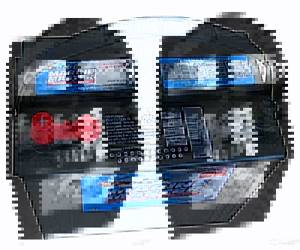
DEKA DOMINATOR 8G24 (USA) helium 12 V – has a unique helium electrolyte technology. Capable of withstanding a large number of charge-discharge cycles. Withstands any load, which will allow you to stay on the water for a long time.
Characteristics:
- Capacity: 74 A*h;
- Max I: 410 A;
- Weight: 19 kilograms;
- Price: about 16,400 rubles.
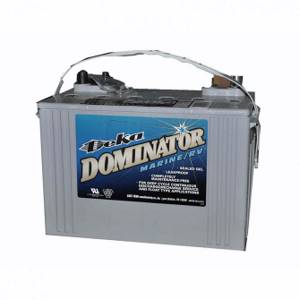
DEKA DOMINATOR 8G31DT (USA) helium 12 V – has many advantages: sealed, maintenance-free, electrolyte does not leak, shock-resistant.
Characteristics:
- Capacity: 102 A*h;
- Max I: 590 A;
- Weight: 31.7 kilograms;
- Price: about 20,900 rub.
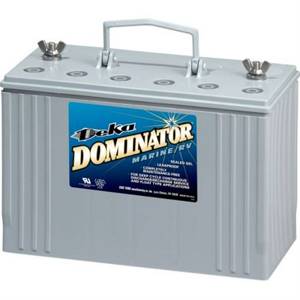
Advantages and disadvantages
Having considered the 2 main types of batteries for a boat, let’s go through their characteristics in more detail and identify their strengths and weaknesses.
So, the advantages of AGM technology
- Affordable price and large selection. Batteries of this type, as a rule, are widely represented in the entry-level price range, however, AGM batteries are also present among expensive models.
- Long service life. If you go fishing every weekend for a year, the battery should last for at least 7 years. The number of charge-discharge cycles is on average more than 800.
- The seal allows the battery to be charged without releasing hazardous substances.
- Possibility to place the battery on its side. Another useful feature is that it is sealed; it is not recommended to turn the item upside down.
- No need for battery maintenance.
Here are its disadvantages
- Inability to store the battery in a completely discharged state. Unlike GEL, the depth of discharge for glass wool type batteries should not exceed 20-30%.
- Reducing stress in cold weather. In cold weather, the battery will produce slightly less voltage. This may affect the efficiency of the motor.
Now let's look at the advantages of GEL
- Lower discharge level when idle. If a charged battery is not used in any way, after a month you can expect a discharge of no more than 5%, which is a good indicator.
- Deep Cycle ability.
- Resistance to extreme temperatures. From -30 to + 60.
- Improved vibration protection. Useful during strong waves.
- Even longer supply of cycle hours. With certain models of gel batteries you can charge the device more than 1000 times.
In general, all lead-acid batteries have common disadvantages.
- Heavy weight. Approximately about 30 kg, sophisticated models can weigh tens of kilograms more.
- Sensitivity to overdischarge. It should not be more than 25%.
- Not environmentally friendly. After use there is a need for special disposal.
Sources
- https://siap.by/stati/akkumulyatory-dlya-lodochnyh-motorov-vidy-osobennosti/
- https://IstochnikiPitaniy.ru/akkumulyatory/avtomobilnye/tyagovye-dlya-lodochnogo-motora.html
- https://www.AutoAKB.ru/ship/
- https://myownship.ru/acessories/akkumulyatory/dlya-elektromotora.html
- https://www.h-energy.ru/lodochnye-akkumulyatory/
- https://akbinfo.ru/vybor/akkumuljator-dlja-lodochnogo-jelektromotora.html
- https://lakeking.ru/lodka/motor/akkumulyator.html
- https://myownship.ru/acessories/akkumulyatory/tyagovyj-dlya-motora.html
Is it possible to use car batteries?
This topic is worth discussing. Experienced fishermen, specialists and tourists say that it is better not to do this. Car batteries are not suitable for boat engines. A car battery works like this: when the engine starts, it produces a high current, and then charges during the trip.
Not every boat internal combustion engine has a generator. They are installed only on expensive models. Most outboard motors are not designed for the battery to be recharged while running.
Under no circumstances should a car battery be used as a traction battery. After 5-7 deep discharges it will stop working.
Car batteries for boat motors
The issue of the working connection between boat motors and car batteries requires special consideration. According to the majority of experts, as well as fishermen and tourists with experience in operating small vessels, the use of car batteries for working with boat engines is inappropriate.
Structurally, a car battery is a starter battery and is designed to operate under constant charging conditions. Only boat internal combustion engines with high power (over 10 hp) are equipped with generators for recharging batteries (or a special place for its installation and connection).
Recharging batteries from low-power motors of small vessels (inflatable boats, boats, etc.) is not provided for by their design. True, at present there are “Alternator Current” and “Battery Charging” kits, which, when installed on low-power internal combustion engines, can recharge car batteries.
However, even with such a generator, a car battery breaks down very quickly, since it is not designed to work in conditions of constant exposure to moisture and strong motion.
Using a car battery as a traction battery for a boat electric motor, after 7-10 cycles of deep discharge and subsequent charging, leads to destruction of the plates and its complete failure.
Blitz tips
Manufacturers of batteries for boats need to look for a compromise combination of starting and traction qualities of batteries. Research is currently underway to achieve this.
An example of such a solution is RT-L traction lithium batteries. Specialists from the Russian Academy of Sciences participated in their development.
Differences between these batteries:
- Light weight, the lightest in its class;
- High energy intensity;
- Protection from climate influences;
- Increased service life (large number of cycles - about 3000).
These batteries cannot be drowned. Special materials were used for manufacturing.
